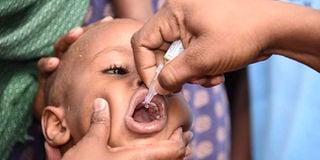Progress as 80pc of Kenyan toddlers are immunised, KDHS data reveals

A child is vaccinated against polio at Hagadera Refugee Camp in Dadaad, Garissa County in September 2018.
The country has made significant progress in childhood immunisation over the past 10 years, with 80 per cent of children aged 12–23 months fully immunised, according to the Kenya Demographic and Health Survey 2022.
In 2003, coverage stood at 57 per cent.
However, experts are concerned about the remaining 20 per cent of children who have not received all their vaccines, posing a risk to themselves and those who have been vaccinated.
Acting Director-General of Health Patrick Amoth stressed the need for a stronger upward trend in immunisation rates.
“We wish we could have a stronger upward trend so that we don’t leave any child behind. Out of every 10 children, 2 have never been vaccinated, which poses a serious risk to those who have been vaccinated,” he said.
Vaccinations have become an essential part of healthcare, preventing the spread of deadly diseases and protecting the well-being of people, especially children. The decision to forgo routine vaccinations can have serious consequences and pose significant risks.
One of the most significant consequences of not vaccinating children is that they become vulnerable to vaccine-preventable diseases. Diseases such as measles, mumps, rubella and whooping cough can wreak havoc on the unvaccinated. These diseases can lead to serious complications, including hospitalisation, long-term disability and death.
Failure to vaccinate children can contribute to the outbreak and spread of infectious diseases. When significant numbers of children are unvaccinated, it creates a breeding ground for the transmission of vaccine-preventable diseases within communities. This not only endangers the health of the unvaccinated children, but also poses an increased risk to those with compromised immune systems. Outbreaks put a strain on health care resources and place a burden on hospitals and health workers.
The KDHS 2022 report reveals striking regional disparities in immunisation coverage across Kenya.
The arid areas, including Mandera, West Pokot, Garissa, Wajir and Marsabit, have the lowest immunisation rates at 6, 11, 17, 19 and 19 per cent, respectively. Ten years ago, when the 2014 KDHS was released, only 51 per cent of children in the northern arid areas were fully immunised.
Conversely, Kisii (71 per cent), Tharaka Nithi (72 per cent), Embu (76 per cent), Kakamega (82 per cent) and Machakos (82 per cent) have the highest immunisation coverage.
“The low immunisation coverage in the northern region highlights the disparities and inequalities that exist, with individual counties facing unique challenges. This disparity raises concerns about the effectiveness of the national average in masking the specific difficulties faced by the regions,” said Dr Amoth.
Vaccine inequality refer to the unequal distribution of vaccines and differences in vaccination rates between different population groups. These inequalities can result from a variety of factors, including socioeconomic status, geographic location, cultural beliefs, access to health care and systemic barriers. Disadvantaged communities, marginalised populations and those in remote or underserved areas are often disproportionately affected by immunisation inequities.
The report also highlights a positive correlation between maternal education and child immunisation coverage. Coverage increased significantly, from 23 per cent among children whose mothers had no education, to 62 per cent among those whose mothers had more than a secondary education.
The public health sector remains the main source of childhood immunisation in Kenya, with about four out of five children receiving their vaccines in public facilities.





